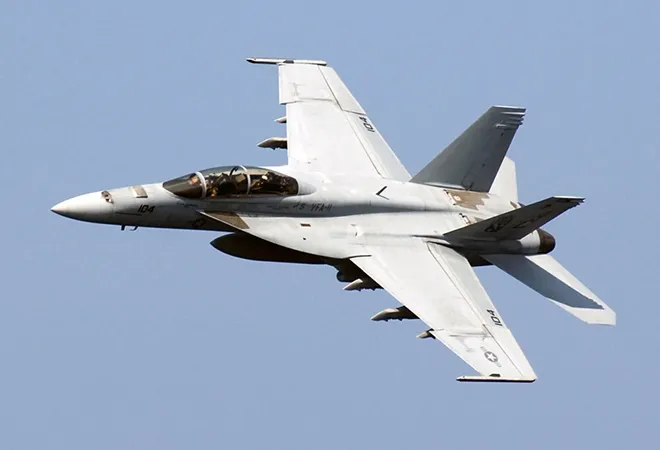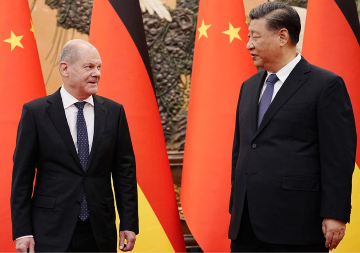
With at least 26 aircrafts to be procured under the Indian Navy’s ongoing Multi-Role Carrier Borne Fighters (MRCBF) programme, and the initial requirement of 57 aircrafts creating the scope for acquiring greater numbers, the two contenders going head-to-head are the Rafale Marine (M) aircraft and the F/A-18 Super Hornet. The
trials have concluded, with the Indian Navy having received the complete data from the tests conducted at the shore-based test facility (SBTF) in Goa.
The time left to choose an aircraft and place orders is limited because
INS Vikrant, India’s second aircraft carrier, is likely to be commissioned into the service of the Indian Navy on 15 August 2022. While INS Vikrant—India’s first indigenously constructed aircraft carrier—can host the Indian Navy’s MiG 29K’s, their underwhelming availability and limited numbers imply that they cannot operate at their full potential from either of India’s aircraft carriers. Hence, the urgent requirement for additional fighter aircrafts.
In a
recent report favouring the F/A-18’s chances, it is claimed that not only has the aircraft successfully completed the SBTF trials, but has also done so with payloads exceeding the Indian Navy’s requirements for ski-jump take-off. The aircraft took off from the testing facility’s ski jump carrying two AGM-84 Harpoon missiles, each weighing 550 kg, for a total loadout of 1100 kg.
The F/A-18 can fold its wings to fit into the elevators of INS Vikrant, while this is a complex task with the Rafale M because its wings cannot be folded.
Also in favour of the Super Hornet is the availability of the twin-seater variant, F/A-18F, while the Rafales only come in single-seat configuration. Further, the F/A-18 can fold its wings to fit into the elevators of INS Vikrant, while this is a complex task with the Rafale M because its wings cannot be folded. While the Rafale M’s wing of 35 feet 9 inches is less than the Super Hornet’s 44 feet 8.5 inches, the latter’s wing can be reduced to 30.5 feet after folding its wings, making it 5 feet less than the Rafale M.
Moreover, commonality of weapons and engines with Indian aircrafts also enhances the F/A-18’s appeal. The Indian Navy’s future twin-engine deck-based fighter shall initially use the F-414 engine, which is also used to power the Super Hornet. The aircraft also enjoys
weapons commonality and interoperability with the Indian Navy’s P-8I Neptune long-range multirole maritime patrol aircraft.
In addition to these technical considerations, the recent
approval of Countering America’s Adversaries through Sanctions Act sanctions waiver for India by the United States (US), in context of the former’s purchase of Russian S-400 air defence systems, could also act as a geopolitical catalyst for the Indian Navy’s purchase of Super Hornets. This can be viewed as a confidence-building measure which is significant when viewed against the backdrop of the lack of mutual trust between the US and India in the past, and the lack of any such waiver for Turkey after it inked a deal to purchase the S-400 in 2017. In fact,
Turkey was stripped off its fifth-generation F-35 aircrafts, as a result of the sanctions.
The scenario with respect to the Indian Air Force (IAF) is quite different from the Indian Navy, with the Rafale’s M88 engine manufacturer having approached the Indian Ministry of Defence with a proposal to set up its
largest aircraft engine maintenance, repair, and overhaul facility in India. This increases the likelihood of selection of the Rafale in the IAF’s 114 multi-role fighter aircraft procurement.
The aircraft also enjoys weapons commonality and interoperability with the Indian Navy’s P-8I Neptune long-range multirole maritime patrol aircraft.
However, from the Indian Navy’s perspective, the Block III variant of the Super Hornet on offer is a decent aircraft given its
lowest maintenance cost among all twin-engine tactical fighter aircraft operated by the US armed forces. Even in terms of its avionics, the Block III variant is quite advanced, and India requires such fighter aircrafts to counter
China which is building new variants of its carrier-borne J-15 fighter aircraft with J-15D as a designated electronic warfare (EW) platform. The E/A-18G Growler, which utilises the same airframe as the F/A-18 Super Hornets, can present the Indian Navy with formidable EW capabilities in times to come.
The US is constantly working to maintain its technological edge over China, and equipping newer technologies on the Super Hornets provide the US Navy an advantage over China’s People’s Liberation Army Navy (PLAN). The same weapon systems can subsequently be operated by the Indian Navy on its Super Hornets, with an eye on the increasing presence of the PLAN in the Indian Ocean Region. Hence, purchase of Super Hornets can herald the beginning of a closer long-term relationship with the US, which shall be beneficial for India, and especially the Indian Navy, in countering the hegemonic blue-water ambitions of the PLAN.
The views expressed above belong to the author(s). ORF research and analyses now available on Telegram! Click here to access our curated content — blogs, longforms and interviews.



 With at least 26 aircrafts to be procured under the Indian Navy’s ongoing Multi-Role Carrier Borne Fighters (MRCBF) programme, and the initial requirement of 57 aircrafts creating the scope for acquiring greater numbers, the two contenders going head-to-head are the Rafale Marine (M) aircraft and the F/A-18 Super Hornet. The
With at least 26 aircrafts to be procured under the Indian Navy’s ongoing Multi-Role Carrier Borne Fighters (MRCBF) programme, and the initial requirement of 57 aircrafts creating the scope for acquiring greater numbers, the two contenders going head-to-head are the Rafale Marine (M) aircraft and the F/A-18 Super Hornet. The  PREV
PREV


